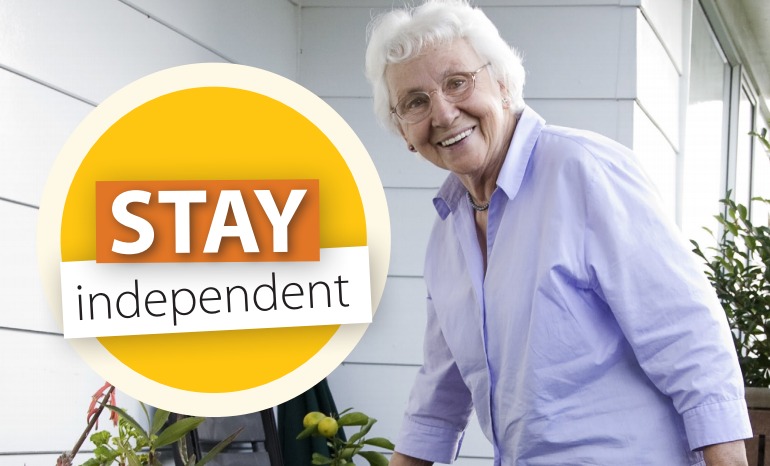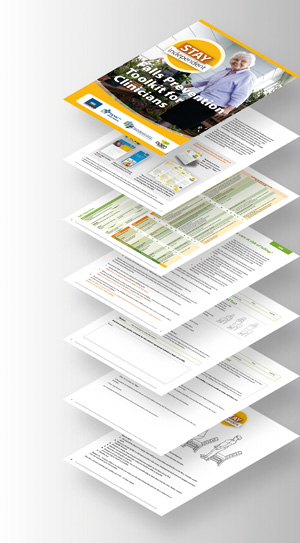 View / Download pdf version of this article
View / Download pdf version of this article
Improving awareness and education
Approximately one in every three people aged over 65 years will fall each year, which for many represents a major loss
of independence.1 It is common for older adults to see falls as unavoidable or chance events, and to not
recognise that there are things they can do to reduce their risk of falling.2 Improving awareness and education
about the risk factors for falls has the potential to reduce the likelihood of fall-related injuries and loss of independence
for older people. Older adults who fall are less likely to have discussed falls, and falls prevention, with their healthcare
providers.3
As part of the Health Quality & Safety Commission’s Standing up to Falls campaign, and following on from April Falls
month, a range of resources, developed in partnership with bpacnz, have been released to increase the awareness
of falls within the community. The Stay Independent clinician toolkit aims to assist health professionals
to highlight the specific factors which may increase a patient’s risk of falling by introducing assessments, exercises
and referral pathways to local programmes which can help reduce this risk. Evidence suggests that multi-factorial assessments
and interventions reduce the rate of falls in older people living in the community.4 With the growing elderly
population, reducing the likelihood of falls is an important step towards reducing health care costs and maintaining independence
and quality of life for older people throughout the country.
“Stay Independent” toolkit

The Stay Independent toolkit includes both patient and clinician specific information and assessment tools.
These resources have been developed to accompany the Health Quality & Safety Commission’s national programme Reducing
Harm from Falls and the Ask, assess, act resources which are currently available throughout the country.
Patient resources
A poster and accompanying brochure (both titled Stay independent) are intended for use in primary care
waiting rooms and receptions. The poster encourages patients to complete a checklist (contained within the brochure),
and provides background information on falls and preventative steps that can be taken to reduce risk. The brochure is
intended to be used by patients before, or during, consultations with the checklist providing ten questions to help identify
any risks. Explanations are provided on why each question is important, and local falls prevention programmes can be noted
on the back of the brochure for the patient to seek further support.
Clinician resources
The clinician toolkit contains a range of information to assist health professionals in determining if an older patient
is at risk of falling. Based around an algorithm which helps guide the assessment of risk factors, the toolkit provides
information on falls and falls prevention, assessments which can help clinicians to identify risk factors in older patients,
and information on changing patient behaviour and attitudes towards falls.
Clinicians can use the checklist in the brochure as a conversation starter with older patients to discuss falls risk
and any concerns the patient has about staying independent. If further investigation is warranted, assessments that can
be conducted within a consultation include the Timed Up and Go (TUG) Test, the 30-Second Chair Stand Test and the Four
Stage Balance Test, as well as assessing for postural hypotension. A combination of two or more of these tests is recommended
to help to identify an older patient who is at risk for falling.5
If the patient has risk factors present, or would benefit from active preventative steps, the toolkit contains a sheet
for recording local falls prevention programmes, and also instructions for a chair stand exercise that a patient can undertake
at home. For patients with multiple risk factors, the toolkit contains a checklist for an in depth assessment, and referral
form for specialist services.
Accessing resources
A copy of the Stay Independent toolkit has been provided with this month’s edition of Best Practice Journal.
The Health Quality & Safety Commission is planning a mail-out of posters and brochures to practices. The toolkit and
downloadable versions of each resource, including the poster and brochure, can also be accessed online at either
the Health Quality & Safety Commission or bpacnz websites:
 www.hqsc.govt.nz/our-programmes/reducing-harm-from-falls/projects/primary-and-community-care/
www.hqsc.govt.nz/our-programmes/reducing-harm-from-falls/projects/primary-and-community-care/
 www.bpac.org.nz/falls
www.bpac.org.nz/falls
 For further information on the Health Quality & Safety Commission’s Standing up to falls campaign, including many
other free resources available for primary care practitioners, patients and their
families/whānau, see:
www.hqsc.govt.nz/our-programmes/reducing-harm-from-falls
For further information on the Health Quality & Safety Commission’s Standing up to falls campaign, including many
other free resources available for primary care practitioners, patients and their
families/whānau, see:
www.hqsc.govt.nz/our-programmes/reducing-harm-from-falls

A message from the Health Quality & Safety Commission
Health Quality & Safety Commission clinical leads Dr Paul Cooper (GP and Clinical Lead-Primary Care) and Sandy
Blake (Director of Nursing and Patient Safety at Whanganui DHB and Clinical Lead – Reducing Harm from Falls
Programme) share some thoughts on how to make best use of this new resource: Stay Independent.
Let’s talk about falls
Let’s talk about falls and how we can raise the awareness of the risk of falling with our patients. Falling is not an
unusual event. We need to be asking the right questions, looking and listening for what is not being said.
Some key facts may be surprising:
- Falls are the leading cause of injury to older people
- After three falls with minor injury a person has a 240% increased risk of a fall with major injury
- Approximately one-third of people aged over 65 years fall each year and the likelihood of falling increases with advancing
age (each year one in every two people aged over 80 years will fall).
How can we reduce harm from falls in older people?
We need to “normalise” talking about the risk of falls and encourage all elderly people to stay as active as possible,
minimising their risk of falling, maintaining their independence and improving their overall quality of life. Falls prevention
requires a partnership approach between the older person, their family and their health care team.
The Ask, assess, act process is a guide to remind us to have the conversation, listen to what we are being told, reflect
on it and take action. The conversation needs to involve the older person, their family/whānau and other carers, in the
identification of falls-related problems and risks that are real for the older person, and lead to shared decisions about
actions which will be most helpful and manageable.
Starting the conversation:
ASK the older person three simple screening questions:
- Have you slipped, tripped or fallen in the last year?
- Can you get out of a chair without using your hands?
- Have you avoided some activities because you are afraid you might lose your balance?
Asking yourself: “Is this older person at risk of falling?” and “what is contributing to this risk?”, often highlights
the number and type of medicines the older person is taking.
What does the patient see as problems and risks associated with falls? Explore with the patient and their family/whānau
what has changed for them?

ASSESS the older person to identify their particular falls risk factors:
- Observe as the patient enters the room or rises from the chair. Assess falls risk factors related to physical activity,
underlying conditions and home safety. Gather some objective information using the tests in the Stay Independent toolkit.
- You might suggest that the patient sees the practice nurse “to do some strength and balance tests and see how we can
maintain your mobility”.
ACT by putting in place individualised interventions and supports to address the older person’s risks:
- Set a partnership plan in motion with the patient in control of their own care. Address the risks identified, discuss
and agree specific actions, consider who else cares for this person and how they can assist.
- Consider ways the older person could enhance balance and strength, e.g. through home-based or community-based exercise
programmes.
- Refer the older person to the ACC home-safety checklist. What things can the patient do in their everyday life to
keep mobile/active?
- Social connection is also very important; consider how the older person can connect with their community.
- Consider what monitoring, investigation or clinical referral might be needed.
- Consider adding the falls questions in your regular “older persons health review”. Add a falls question to the medicines
template in your practice management system, e.g. Medtech.
 Remember that medicines (e.g. medicine class, number of medicines, interactions) are one of the major contributors
of falls in older people. Medicines are easy to start and more difficult to stop and as people age we need to accurately
seek out the risk of prescribed medicines. Consider: Is this a necessary and useful medicine, do the benefits outweigh
the risks?
Remember that medicines (e.g. medicine class, number of medicines, interactions) are one of the major contributors
of falls in older people. Medicines are easy to start and more difficult to stop and as people age we need to accurately
seek out the risk of prescribed medicines. Consider: Is this a necessary and useful medicine, do the benefits outweigh
the risks?
Clinical pathways for “falls, frailty, and older people” are in development around the country; the Stay Independent toolkit
provides some tests, checklists and context which might be useful to incorporate in these pathways.
 If you have any feedback or questions about the Stay Independent toolkit
or the Health Quality and Safety Commission’s falls programme, please contact Bridgette Connor, Project Manager
– Reducing Harm from Falls. Email: bridgette.connor@hqsc.govt.nz
If you have any feedback or questions about the Stay Independent toolkit
or the Health Quality and Safety Commission’s falls programme, please contact Bridgette Connor, Project Manager
– Reducing Harm from Falls. Email: bridgette.connor@hqsc.govt.nz
References
- Ambrose AF, Paul G, Hausdorff JM. Risk factors for falls among older adults: A review of the literature. Maturitas
2013;75(1):51–61.
- Stevens JA, Noonan RK, Rubenstein LZ. Older adult fall prevention: Perceptions, beliefs, and behaviors. Am J Lifestyle
Med, 2010;4(1):16–20.
- Lee D, Day L, Hill K, et al. What factors influence older adults to discuss falls with their health-care providers?
Health Expectations, 2013.
- Gillespie LD, Robertson MC, Gillespie WJ, et al. Interventions for preventing falls in older people living in the
community. Cochrane Database Syst Rev 2012;(9):CD007146.
- Barry E, Galvin R, Keogh C, et al. Is the Timed Up and Go test a useful predictor of risk of falls in community
dwelling older adults: a systematic review and meta-analysis. BMC Geriatrics 2014;14(1):14.